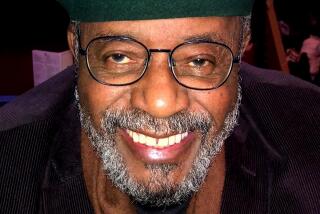Tom Selleck’s old-school sensibilities steady ‘Blue Bloods’
Tom Selleck says he’s scared.
He has spent so much of the winter holidays working on the script for the next “Jesse Stone” that he’s afraid he’s lost touch with Frank Reagan, the character he plays in the CBS hit police drama “Blue Bloods.” So he’s flying back to New York, where “Blue Bloods” is set and filmed, a few days early to immerse himself in Frank’s world.
FOR THE RECORD:
Tom Selleck: An article in the Feb. 13 Calendar section about Tom Selleck and his work on the CBS police drama “Blue Bloods” described the actor as “a true baby boomer.” Selleck was born in 1945, a year before the start of the baby boom generation, which extends from 1946 to 1964. —
“It’s been a while since I’ve had to juggle,” he says.
He doesn’t look scared. He looks like Tom Selleck, only bigger. In the entertainment world where the most formidable-looking actor can turn out to be 5-foot-8 and 160 pounds in real life, Selleck, at 6-foot-4, occupies a lot of space. When “Blue Bloods” premiered last fall, he was the big draw; a television star returning after years away. He wasn’t the only one — Ed O’Neill is on “Modern Family,” Ted Danson is on “Damages” and “Bored to Death,” Ray Romano stars in “Men of a Certain Age” — but he is the most unchanged. Whereas O’Neill and Romano have done 180s from their famous roles and Danson twists his former lover-boy persona into quasi-satire, Selleck’s performance as Police Commissioner Frank Reagan is but a variation on a theme: The big man in the room, plagued by enough heartache to make him interesting but still a force of decency, capable of nailing a serial killer with one shot and manly enough to flash the occasional dimple.
This doesn’t mean Selleck is one-note — Magnum had a much lighter touch, and heart, than Jesse Stone, Robert Parker’s depressed detective whom Selleck portrays in CBS’ popular ongoing movie series — while Frank Reagan is layered with the years he has spent as a New York cop. But with that square jaw and barrel chest, Selleck is not built for the sardonic or fey antihero that has recently been in vogue. At 66, he is a true baby boomer, but he doesn’t do snark or puer aeternus angst; he isn’t post-modern, post-Jungian or post-anything. He’s Tom Selleck. He rolls old school.
He just had to wait awhile for television to catch up.
Created by “The Sopranos’” alumni Mitchell Burgess and Robin Green, “Blue Bloods” is a modern revamp of rock solid network programming. It’s a police procedural that does not wallow in gore wrapped in an ongoing family drama that does not shy away from sentiment. Selleck’s Frank is the anchor of four generations who sit down for Sunday dinner every week to discuss life as experienced by a family that includes four police officers and a district attorney. It’s a perfect role for Selleck, and one that took years to find.
“I was offered a lot of slam-dunk procedurals which were so boring I would go bananas,” he says, talking in his publicist’s Beverly Hills office. “Or really marginal shows that maybe weren’t that good but they figure if they get a name they could sell it.”
When he saw the “Blue Bloods” script, he was struck by the ensemble nature of it. “We’re getting back to the roots of television,” he says. “The best stories are always character-driven, but we can show you the highs and the lows, the big moments and the quiet ones. That’s unique to series television — getting the audience to really invest, to pay attention.”
Selleck is a serious student of his art and speaks well about it. Having served as an executive producer and writer on “Jesse Stone” he can walk you through the difficulties of modern pilots — “the hour form almost dooms any pilot because you can’t introduce characters and give the audience ‘a typical episode,’ which is what the networks want” — and explain the advantages of shooting on 16-millimeter film (saves money and looks like a feature film.) He loves “Blue Bloods’” dinner scenes mainly because they mean that the whole cast works together regularly — “in some shows you can go months without ever working with or seeing your costars.” He speaks of his cast in a proud paternal, which is not to say patronizing, way, pointing out on several occasions that for all Selleck’s headliner draw, Donnie Wahlberg, who plays police detective Danny Reagan, does much of the show’s heavy lifting and injects the show with the necessary moments of humor. “Donnie just knows when to flip a line,” Selleck says. “I love to watch him work.”
Also, for the record, Selleck does not think his nice-guy persona would prevent him from playing a serial killer. “The director of our pilot also directed ‘Dexter,’” Selleck says. “The key to Magnum was that he woke up one day at 33 and realized he had never been 23. I could still work with that, in an elderly way, but you’d need that kind of charm.”
Although it’s difficult to find an actor who doesn’t sing the praises of character over high concept, Selleck has walked the walk, most noticeably with Jesse Stone, but even with Thomas Magnum. When “Magnum, P.I.” debuted in 1980, police and detective dramas revolved around stories that were neatly tied up at the end of the episode by a small cast of characters. A year later, Steven Bochco broke the mold with “Hill Street Blues,” but “Magnum,” with its luxe Hawaiian setting and reliance on hot cars and hot women, was not going for realism. Still, Selleck fought to make his character multidimensional.
“When ‘Magnum’ started,” he says, “There were no cumulative narrative shows except the nighttime soaps. But I had had a lot of time to think about what I really wanted to do — I didn’t get ‘Magnum’ till I was 35 — so I started making notes to keep him and his back story consistent.”
After “Magnum” ended in 1988, Selleck did a bunch of movies, for the big screen and small, and banged around a bit, starring in the short-lived “The Closer,” famously guest-starring in “Friends” and later “Boston Legal.” Somewhere in there CBS’ Les Moonves came calling.
“I had done a lot of successful movies on cable,” Selleck says, “and CBS said, ‘Why don’t you do a movie with us?’ I said, ‘I don’t like the ones you make, but if you’re saying I can make a movie that’s a movie, OK.’ ”
He became executive producer as well as star of “Jesse Stone: Stone Cold.” He saw the film as a character piece as much as a murder mystery with thoughtful (read: slow) pacing. Not surprisingly the networks balked. “They freaked out,” he says. “They hated the movie because it was expensive, and they just threw it out there thinking, ‘Well, maybe Tom will open it.’”
He did, to high enough numbers that Moonves called the next day and asked if Selleck wanted to turn it into a one-hour series. Selleck said no, he didn’t want to feed the stories through the weekly grinder. CBS was not thrilled — the whole concept of the movie of the week was all but extinct, so there was no real rubric for the films. But he kept on making them, and CBS kept on airing them to solid ratings — the last two drew 15 million and 11 million viewers.
“Blue Bloods,” though an ensemble, shares many of its characteristics with “Jesse Stone,” including a slower pace and a deep exploration of character. In many ways, the series resembles its headliner: big, steady and certain of itself, racking up such high ratings in the dead zone of Friday night that CBS recently decided to give it a trial run on Wednesday. Like Selleck, “Blue Bloods” seems intent on proving that you don’t always need CG-enhancement and hand-held cameras to make a hit. That in the end it’s hard to beat a good, character-driven, multi-story serial drama.
“That’s the bread and butter of television,” Selleck says, not sounding scared at all. “And it’s time to get back to it.”
More to Read
The biggest entertainment stories
Get our big stories about Hollywood, film, television, music, arts, culture and more right in your inbox as soon as they publish.
You may occasionally receive promotional content from the Los Angeles Times.











